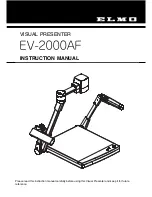
TM-6740GE Series
14
Installation
2.2.3.3
Building Your Own Power Cable
Refer to the 12-pin connector pin-out in Table 1 on page 12. Connect the Ground lead to pin #1, and the +12V
DC lead to pin #2 of the 12-pin connector. Power must be DC-regulated, and of sufficient current to properly
power the camera.
2.2.3.4
Attaching the Power Cable to the Connector
The 12-pin connector is keyed and will only fit in one orientation. To properly attach the power cable to the
camera connector, use the following steps:
1.
Rotate the connector while applying slight pressure until the keyways line up.
2.
Press the connector into place until firmly seated.
3.
Plug the power cord into the 100V AC socket. This powers up the camera.
Note: If using a power supply other than the standard PD-12U Series from JAI, certain characteristics are
required of the power supply and the wiring in order to properly power the camera. The camera requires
12V immediately upon start-up; no slow ramps. Once power is applied, the power supply must be able to
support a 2A to 2.5A in-rush current for approximately 200µs to prevent the voltage at the camera from
dropping below the 10.8V minimum required. Dropping below this will result in the camera’s internal
power supply lowering its impedance in an attempt to draw more current. Since no more current will be
available, the voltage at the camera will drop instead. This will result in a steady state hang-up which
will damage the camera’s power supply and cause the camera to cease operating or to operate in an
unstable manner.
2.2.4
Attaching the Camera Lens
The TM-6740GE camera accepts 1/3" or larger format size C-mount lenses. To attach the C-mount lens to the
camera, carefully engage the threads and rotate the lens clockwise until it firmly seats on the mounting ring.
Do not force the lens if it does not seat properly.
Note: Some lenses with extremely long flangebacks may exceed the mounting depth of the camera.
C-mount to F-mount and C-mount to K-mount adapters are available for larger format lenses (35mm). Check
with local photography dealers for these lens adapters.
2.2.5
Adjustable Back-Focus
Before cameras are shipped, back focus is carefully set using a collimator, oscilloscope and other specialized
equipment. While the factory-set focus serves well in most cases, an adjustable back focus makes it possible to
improve image sharpness when using lower-cost zoom lenses, custom optics, or in unusual parameters.
There should be an obvious need to refocus the lens before attempting to change the back focus. This is a very
exacting task. Some cameras have been returned to the factory to reset the back focus after failed attempts to
change the focus by customers. It might be wise to label cameras whose back focus was adjusted
The camera must be connected to a monitor before attempting to adjust the back focus.
1.
To back focus the camera, first attach a C-mount lens in the mount. Be certain that the lens is properly
seated.
2.
Next set the lens focus to infinity (if the lens is a manual iris, set the iris to a high f number while still
retaining a well illuminated image).
3.
Loosen the three miniature hex set-screws (use a 0.9 mm hex wrench) that lock the focus ring in place
(two screws for a CS-mount). Slowly turn the lens and focus ring assembly back and forth until you obtain
the best image of the desired object. This sets the back focus. Once the best image is obtained, tighten
the focus ring set-screws until they are snug. Do not over-tighten the screws. Note: Mini-bayonet cameras
adapted to C-mount do not have the back focus feature.
Summary of Contents for TM-6740GE
Page 2: ......
Page 15: ...Installation 15 TM 6740GE Series Figure 4 Back Focus Set Screw Locations...
Page 26: ...TM 6740GE Series 26 Operation 3 8 Camera Timing Charts...
Page 27: ...Operation 27 TM 6740GE Series...
Page 28: ...TM 6740GE Series 28 Operation...
Page 34: ......
Page 70: ...TM 6740GE Series 70 Appendix...
Page 71: ......















































